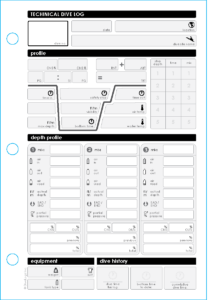Diving is a fun recreational activity, as well as a professional activity for some individuals, that allows you to explore underwater environments teeming with marine life. Because each dive offers a unique experience, though, you should document them in a dive log. Dive logs contain several sections that you complete with information pertaining to a specific dive. While using dive logs may sound like a simple enough task, many newcomers are guilty of making one or more common mistakes. In this post, you’ll learn about the seven most common dive log mistakes and how to avoid them.
#1) Estimating Your Entries
You might feel compelled to estimate the entries in your dive logs rather than calculating them. After all, it’s easier to guess how much air you used or how long you spent in the water (bottom time). But estimating your entries defeats the purpose of using dive logs, which is to provide a documented journal of your dives. If you estimate the entries — whether for air consumption, bottom time, weight usage, water temperature or any other field — you won’t have an accurate record of your dives. It takes a little more time and effort to calculate your entries, but doing so will help you create a more accurate journey of your dives.
#2) Not Getting Dive Logs Signed or Stamped
Another common mistake to avoid when using dive logs is not getting them signed or stamped. After completing the fields in a dive log, ask your instructor — or a buddy if you’re diving without an instructor — to sign or stamp it. Having your dive logs signed or stamped by a third party verifies your entries. And if you’re planning to obtain a diving certification, you’ll need to show instructors that you’ve performed a minimum number of dives, which is only possible if your dive logs are signed or stamped.
To enroll in the Professional Association of Diving Instructors (PADI) Divemaster course, for example, you’ll need at least 40 logged dives. To enroll in the PADI Instructor Development Course (IDC), you’ll need at least 60 logged dives. And to take the PADI Instructor Examination (IE), you’ll need at least 100 logged dives. By getting your dive logs signed or stamped, you can work towards achieving these or other diving certifications. The course instructor can see that you completed a specific number of dives, allowing you to enroll in the course and, eventually, achieve your desired diving certification.
#3) Using Only Digital Dive Logs
 What’s wrong with using digital dive logs? You can use software, either on your smartphone or computer, to digitally log your dives, but you should still use physical dive logs as well. Relying strictly on digital dive logs is never a good idea. First, it’s easier to make mistakes when typing dive log entries as opposed to writing them on paper. You may mistype an entry, resulting in the wrong information being recorded. Second, digital dive logs are prone to technical errors. Even you type an entry correctly, the software could change or delete it. Third, relying on digital dive logs means you’ll have to take your device onto the boat, which could result in it getting damaged. If you’re going to use digital dive logs, make sure you use paper dive logs as well.
What’s wrong with using digital dive logs? You can use software, either on your smartphone or computer, to digitally log your dives, but you should still use physical dive logs as well. Relying strictly on digital dive logs is never a good idea. First, it’s easier to make mistakes when typing dive log entries as opposed to writing them on paper. You may mistype an entry, resulting in the wrong information being recorded. Second, digital dive logs are prone to technical errors. Even you type an entry correctly, the software could change or delete it. Third, relying on digital dive logs means you’ll have to take your device onto the boat, which could result in it getting damaged. If you’re going to use digital dive logs, make sure you use paper dive logs as well.
#4) Not Completing Logs Immediately After Diving
Some divers wait hours or even days after resurfacing to complete their dive logs. While postponing the completion of your dive logs sounds harmless, it can affect the accuracy of your entries. If you wait too long, you may forget specific information about a dive. Maybe you can’t remember what type of wetsuit you wore during the dive, or perhaps you can’t remember the duration of the dive. Regardless, if you can’t remember the information for a specific field in your dive log, you won’t be able to create an accurate entry.
To ensure the accuracy of your entries, complete your dive logs immediately after resurfacing. If you’re still on the boat, you can check your equipment to calculate your entries, or you can ask your instructor for help. But if you’ve already returned to your home, you may struggle to remember key information about the dive, resulting in inaccurate entries. By completing your dive logs immediately after diving, you’ll remember essential information about the dive more easily.
#5) Leaving the Comments Section Empty
Since it doesn’t require any specific information, the comments section of dive logs is often overlooked by beginner divers. Many beginners will complete the header, profile, equipment and conditions sections while leaving the comments section empty. Why is this a problem? Well, the comments section allows you to record any relevant or meaningful information about the dive. Among other things, you can use the comments section to record the type of marine life you encountered, your comfort level, any challenges you encountered and more. If you skip the comments section, your dive logs won’t contain this information. Whether this is your first dive or your 100th dive, take advantage of the comments section to record information about your dives that doesn’t fit into other sections.
#6) Using Low-Quality Dive Logs
Don’t make the mistake of using low-quality dive logs. You’ll need to carry your dive logs onto the boat so that you can complete it immediately after diving. If they are poorly made, however, exposure to saltwater could damage or destroy them. Some divers print out low-quality dive logs using computer printer, only to discover that they are quickly ruined when exposed to saltwater. You can avoid this headache by using high-quality dive logs secured in plastic sleeves.
The dive log books sold here at Dive Logz contain 50 individual dive log pages wrapped in a protective poly sleeve. While you shouldn’t toss your dive log book in the ocean, you can rest assured knowing the poly sleeve will protect it from splashed water, which could otherwise cause it to deteriorate. Low-quality dive logs offer little or no protection against saltwater. As a result, they are easily damaged when carried aboard boats during diving trips. The good news is that you can avoid damage such as this by choosing high-quality dive logs.
#7) Not Reviewing Your Dive Logs
 Finally, you should review your dive logs on a regular basis to gain a better understanding of your past dives. Dive logs are useful because they provide insight into your dives, and you can use this information to better plan your future dives. If you were uncomfortably cold during a specific dive, for example, you can analyze your dive log to see what type of wetsuit you wore. If you wore a 4/3 mm wetsuit during the dive, you’ll know that a thicker wetsuit is needed when diving in the same area around the same time of year. If you don’t review your dive logs, though, you won’t be able to take advantage of the information recorded in them.
Finally, you should review your dive logs on a regular basis to gain a better understanding of your past dives. Dive logs are useful because they provide insight into your dives, and you can use this information to better plan your future dives. If you were uncomfortably cold during a specific dive, for example, you can analyze your dive log to see what type of wetsuit you wore. If you wore a 4/3 mm wetsuit during the dive, you’ll know that a thicker wetsuit is needed when diving in the same area around the same time of year. If you don’t review your dive logs, though, you won’t be able to take advantage of the information recorded in them.
You don’t have to review your dive logs on a weekly or even monthly basis. But if you’re planning a dive at a location where you’ve dived in the past, take a few minutes to look over the dive log. Assuming you completed all the relevant fields properly, it will give a better idea of what to expect during your upcoming dive.
Want to create your own custom dive logs? Contact us today to learn more about our custom dive logs.



